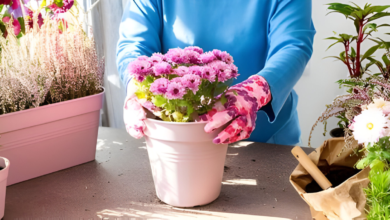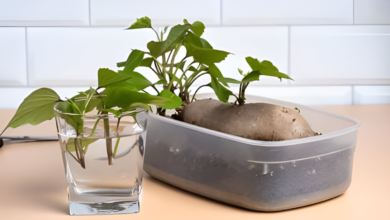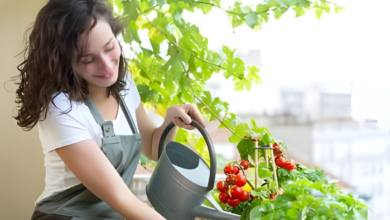5 Steps to Successfully Grow Roma Tomatoes in a Pot

Table of Contents:
- Choosing the Right Pot and Soil
- Selecting the Best Location for Your Roma Tomatoes
- Planting Your Roma Tomato Seeds or Seedlings
- Providing Proper Care and Maintenance
- Watering and Fertilizing Your Roma Tomatoes
- Pruning and Training Your Roma Tomato Plants
- Dealing with Pests and Diseases
- Harvesting Your Roma Tomatoes
- Troubleshooting Common Issues
- Enjoying the Fruits of Your Labor
Choosing the Right Pot and Soil
When it comes to growing Roma tomatoes in a pot, selecting the right pot and soil is crucial for their success. Here’s what I recommend:
- Pot Size: Choose a pot that is at least 5 gallons in size to provide ample space for the Roma tomato plant’s root system to spread out. A larger pot will also help prevent the plant from becoming root-bound.
- Material: Opt for a pot made of a durable material like plastic or ceramic. Make sure the pot has drainage holes at the bottom to prevent waterlogging, which can lead to root rot.
- Soil Type: Use a high-quality potting mix that is well-draining and lightweight. Avoid using garden soil, as it can compact in pots and hinder root growth. Look for a mix specifically designed for container gardening or vegetables.
- pH Level: Roma tomatoes prefer slightly acidic soil with a pH level between 6.0 and 6.8. You can adjust the pH of the soil by adding amendments like lime to raise the pH or sulfur to lower it.
- Fertilization: Consider mixing in a slow-release fertilizer or organic compost into the soil before planting your Roma tomato. This will provide the plant with the necessary nutrients for healthy growth throughout the season.
Choosing the right pot and soil is the foundation for successfully growing Roma tomatoes in a pot. By providing the plant with a suitable environment to thrive, you’ll be on your way to enjoying a bountiful harvest of delicious Roma tomatoes.
Selecting the Best Location for Your Roma Tomatoes
I must consider a few crucial factors when selecting the perfect location to grow my Roma tomatoes. Here are some key points to keep in mind:
- Sunlight: Roma tomatoes thrive in full sunlight, so I need to choose a spot that receives at least 6-8 hours of direct sunlight daily.
- Protection: It is essential to protect my Roma tomatoes from strong winds that can damage the plants. I should select a location shielded from gusty winds or use a windbreak if necessary.
- Temperature: Roma tomatoes prefer warm temperatures, so I must choose a location with good airflow to prevent heat buildup, especially during hot summer days.
- Accessibility to Water: I need to place my Roma tomato plant close to a water source to ensure easy and regular watering, as consistent moisture is key to their growth.
- Space: As Roma tomato plants can grow quite tall and need support, I should select a location with ample vertical space or provide sturdy stakes or trellises for them to climb.
- Soil Quality: Optimal soil conditions are crucial for Roma tomatoes. I should choose a location with well-draining, fertile soil enriched with organic matter for the best results.
By carefully considering these factors and selecting a suitable location for my Roma tomatoes, I can help ensure a successful and bountiful harvest.
Planting Your Roma Tomato Seeds or Seedlings
I prefer to start my Roma tomato plants from seeds indoors about 6 to 8 weeks before the last frost date in my area. Here are the steps I follow to plant my Roma tomato seeds or seedlings:
- Preparing the Containers: I use small pots filled with a high-quality potting mix. Ensure the containers have drainage holes at the bottom to prevent waterlogging.
- Planting Roma Tomato Seeds:
- I plant 2-3 seeds per pot, about 1/4 inch deep in the soil.
- Lightly cover the seeds with soil and water gently.
- Place the pots in a warm, sunny spot or under grow lights.
- Caring for Roma Tomato Seedlings:
- Keep the soil consistently moist but not waterlogged.
- Once the seedlings have two sets of true leaves, I thin them to the strongest one per pot.
- Provide a source of light for 14-16 hours a day to help them grow strong.
- Transplanting Seedlings:
- After the last frost date, I transplant the seedlings into a larger pot or directly into the garden.
- Ensure the soil is well-draining and enriched with compost.
- Supporting Growth:
- As the Roma tomato plants grow, I stake or cage them to support their development.
- Regularly prune any suckers that form in the leaf axils to focus plant energy on fruit production.
By following these steps, I ensure my Roma tomato plants get off to a strong start and thrive throughout the growing season.
Providing Proper Care and Maintenance
I have successfully grown my Roma tomatoes in a pot, and providing proper care and maintenance is key to their health and productivity. Here are some essential steps to ensure your Roma tomatoes thrive:
- Watering:
- Consistency: Water your Roma tomatoes regularly, keeping the soil evenly moist but not waterlogged.
- Frequency: Depending on the weather, I water my Roma tomatoes every 2-3 days, adjusting as needed.
- Watering Technique: Direct the water at the base of the plant to avoid wetting the foliage, which can lead to disease.
- Pruning and Training:
- Suckers: Regularly remove suckers – the small shoots that grow in the crotch between the stem and branches – to encourage fruit production.
- Staking: Use a stake or cage to support the plant as it grows, preventing the branches from breaking under the weight of the fruit.
- Fertilizing:
- Balanced Fertilizer: Feed your Roma tomatoes with a balanced fertilizer every 2-3 weeks to ensure they have the nutrients they need for healthy growth.
- Organic Options: Consider using organic fertilizers to avoid chemical buildup in the soil.
- Pest and Disease Control:
- Inspection: Regularly check your Roma tomatoes for signs of pests like aphids or diseases like blight.
- Natural Remedies: Use natural pest control methods like neem oil or garlic spray to protect your plants without harsh chemicals.
- Harvesting:
- Ripeness: Harvest your Roma tomatoes when they are fully ripe on the vine for the best flavor.
- Gentle Handling: Handle the tomatoes carefully to avoid bruising or damaging the fruit.
Taking these steps to provide proper care and maintenance for your Roma tomatoes will help you enjoy a bountiful harvest of delicious, home-grown tomatoes.
Watering and Fertilizing Your Roma Tomatoes
I ensure my Roma tomatoes receive adequate water to thrive. Here are some essential tips for watering and fertilizing these plants effectively:
- Regular Watering:
- I make sure to water my Roma tomatoes consistently, ensuring the soil remains moist but not waterlogged. Tomatoes need about 1-2 inches of water per week to develop properly.
- To check if they need water, I stick my finger into the soil; if it feels dry about an inch down, it’s time to water.
- Watering Technique:
- I prefer watering my Roma tomatoes at the base of the plant to avoid wetting the foliage, as this can lead to diseases.
- Using a soaker hose or watering early in the day helps prevent evaporation and ensures the plants have ample water.
- Fertilizing Routine:
- I feed my Roma tomatoes with a balanced fertilizer, typically high in phosphorus and potassium to promote fruiting. I do this every couple of weeks during the growing season.
- Over-fertilizing can lead to excessive foliage growth at the expense of fruit production, so I stick to the recommended dosage on the fertilizer package.
- Organic Options:
- If I prefer organic methods, I use compost or manure to fertilize my Roma tomatoes. These natural fertilizers provide essential nutrients to the plants without harsh chemicals.
- Organic options help improve soil quality over time, creating a healthier environment for the tomatoes to grow.
By paying attention to watering and fertilizing, I ensure my Roma tomatoes have the necessary nutrients and moisture to develop into delicious, bountiful fruits.
Pruning and Training Your Roma Tomato Plants
I always make sure to prune and train my Roma tomato plants properly to ensure optimal growth and fruit production. Here’s how you can do it too:
- Pruning:
- I regularly prune the suckers that form in the crotches of the tomato plant. This helps direct the plant’s energy towards fruit production rather than excessive foliage growth.
- Using clean garden shears, I carefully remove any unwanted branches or leaves that may be hindering air circulation or sunlight exposure to the plant.
- Training:
- I use stakes or cages to support my Roma tomato plants as they grow. This helps prevent them from bending or breaking under the weight of the fruit.
- As the plant grows, I gently tie the main stem to the stake using soft garden twine. This encourages upward growth and ensures a straight, sturdy stem.
- I also prune the lower leaves of the plant to prevent them from touching the ground, which can reduce the risk of disease.
By regularly pruning and training your Roma tomato plants, you can help them grow strong and healthy, leading to a bountiful harvest of delicious tomatoes.
Dealing with Pests and Diseases
I always keep a close eye on my Roma tomato plants to ensure they remain healthy and free from pests and diseases. Here are some steps I follow to deal with any issues that may arise:
- Inspect the Plants Regularly: I regularly inspect my Roma tomato plants for any signs of pests or diseases. Early detection is key to preventing any issues from spreading.
- Control Pests Naturally: If I notice pests such as aphids or caterpillars on my plants, I use natural remedies like neem oil spray or insecticidal soap to control them. These methods are effective and safe for the plants.
- Practice Crop Rotation: To prevent the buildup of pests and diseases in the soil, I rotate the location of my Roma tomato plants each growing season. This helps maintain soil health and reduces the likelihood of infestations.
- Provide Proper Air Circulation: Good air circulation is essential for preventing common tomato diseases like powdery mildew and blight. I ensure that my plants have enough space between them to allow air to flow freely.
- Remove Affected Leaves: If I notice any leaves that show signs of disease, such as yellowing or spotting, I promptly remove them to prevent the spread of infection. This helps keep the plant healthy and thriving.
By following these steps and staying vigilant, I can effectively deal with pests and diseases that may affect my Roma tomato plants, ensuring a successful growing season.
Harvesting Your Roma Tomatoes
I look forward to the moment when my Roma tomatoes are ripe and ready to be harvested. Here are the steps I follow to ensure a successful harvest:
- Check for Ripeness: Before picking Roma tomatoes, I always check for ripeness by gently squeezing them. They should be firm but give slightly under pressure. The tomatoes should also have a deep red color and feel heavy for their size.
- Use Pruning Shears: To harvest Roma tomatoes, I prefer using pruning shears instead of twisting or pulling the fruits from the plant. This method helps prevent damage to the plant and ensures a clean cut.
- Harvest Carefully: When harvesting Roma tomatoes, I make sure to hold the vine gently with one hand while using the pruning shears with the other hand to snip the stem just above the tomato. This technique helps avoid harming the plant and ensures the tomatoes stay fresh longer.
- Timing is Key: I always prefer to harvest Roma tomatoes in the morning when the weather is cooler, and the fruits are crisp. It is essential to avoid harvesting tomatoes during the hottest part of the day, as they can become soft and bruised quickly.
- Store Properly: After harvesting Roma tomatoes, I store them at room temperature away from direct sunlight. If the tomatoes need to ripen further, I place them in a paper bag with a banana or apple to speed up the process. Once ripe, I store them in the refrigerator to prolong their shelf life.
Harvesting Roma tomatoes is a rewarding experience, and following these steps ensures that I enjoy delicious, homegrown tomatoes throughout the season.
Troubleshooting Common Issues
When growing Roma tomatoes in a pot, I may encounter some common issues that could affect the health and yield of my plants. Here are some troubleshooting tips to address these problems effectively:
Yellowing Leaves:
If I notice my Roma tomato plant’s leaves turning yellow, it could be a sign of nutrient deficiency, overwatering, or pests. I will inspect the plant for any signs of pests and adjust my watering schedule. Additionally, I may need to provide a balanced fertilizer to replenish any lacking nutrients.
Yellowing Leaves:
If I notice my Roma tomato plant’s leaves turning yellow, it could be a sign of nutrient deficiency, overwatering, or pests. I will inspect the plant for any signs of pests and adjust my watering schedule. Additionally, I may need to provide a balanced fertilizer to replenish any lacking nutrients.
Wilting Plants:
Wilting Roma tomato plants could be due to underwatering, root rot, or extreme temperatures. I will ensure the plant is receiving adequate water without being waterlogged and check for proper drainage in the pot. Adjusting the watering schedule and providing shade during hot weather can help revive wilting plants.
Pests and Diseases:
Common pests like aphids, whiteflies, or diseases like blight can affect Roma tomato plants. I will inspect the plant regularly for any signs of pests or diseases and take necessary action, such as using organic pesticides or fungicides as a preventative measure.
Fruit Set Issues:
If my Roma tomato plant is not setting fruit, it could be due to poor pollination, extreme temperatures, or lack of nutrients. I may need to gently shake the plant to aid in pollination or consider hand-pollinating. Ensuring the plant is well-fed with a balanced fertilizer can also promote fruit growth.
Stunted Growth:
Stunted growth in Roma tomato plants can be caused by overcrowding, lack of sunlight, or poor soil quality. I will ensure the plant has adequate space to grow, receives at least 6-8 hours of sunlight daily, and use quality potting mix with proper drainage for optimal growth.
By being attentive to these common issues and implementing the appropriate troubleshooting steps, I can ensure the successful growth of Roma tomatoes in my pot.
Enjoying the Fruits of Your Labor
I have spent weeks nurturing my Roma tomatoes, and now it’s time to enjoy the rewards of my hard work. Here are some tips to make the most out of the delicious fruits that you have grown:
- Harvesting: When your Roma tomatoes are ripe and ready for picking, gently twist the fruit until it separates from the stem. Be careful not to squeeze too hard to avoid damaging the tomato.
- Storing: If you have more tomatoes than you can eat right away, store them in a cool, dry place away from direct sunlight. You can also freeze or can them to enjoy them throughout the year.
- Cooking: Roma tomatoes are perfect for making sauces, salsas, and salads. I love using them in fresh pasta dishes or simply slicing them up with basil and mozzarella for a classic Caprese salad.
- Sharing: If you have an abundance of Roma tomatoes, don’t hesitate to share them with friends, family, or neighbors. They will surely appreciate the fresh, homegrown produce.
- Reflecting: Take a moment to appreciate the effort you put into growing your Roma tomatoes. Whether you are a seasoned gardener or a beginner, savoring the taste of your own harvest is always a satisfying experience.




